Misyon Online - May-June 2014
Columbans celebrate 80 years in Korea
In the Midst of a Storm
By Anne B. Gubuan
The Philippines has 7,107 islands of which about 2,000 are inhabited. When typhoon Yolanda (Haiyan) struck the country, all eyes were on Samar, where it first hit, and neighboring Leyte. You could just imagine how many other islands in the Visayas were affected that people hadn’t heard of. My officemates and I were privileged to get to know one of these islands when Malta-Filcom, a Filipino community in Malta, chose our office to help facilitate the rebuilding of one school in Barangay Barangkalan, Calagnaan Island, Iloilo.
Headed by their president, Veronica Ugates, Malta-Filcom members shared their little savings having in mind how their fellow Filipinos bore the brunt of Yolanda. ‘It makes us feel better somehow knowing that we have become instrumental in bringing hope to our fellowmen’, shared Estrelleta Gatt when she and her husband came to visit us in the Misyon editorial office during their short vacation in, Bacolod City, Philippines.
It took us three hours to reach the town of Estancia and from there a pump boat took us to the island. We had to hire two pump boats, one for the 180 pieces of galvanized iron roofing we had bought with the money donated by Malta-Filcom and another one for our small of group of about 20 composed of Misyon staff, and the parish pastoral council of Camp Martin Delgado, Iloilo City, of the Philippine National Police, headed by PNP chaplain Fr Ronilo A. Datu. It was the same group we went with last year when we brought relief goods to typhoon victims in the towns of Sara and Estancia, Iloilo.
‘You should go to Calagnaan Island, this time. Very little help reaches the people there’, suggested one of the social workers that we contacted while planning the trip. We were able to get in touch with the barangay captain and he said that the entire roof of their elementary school had been blown away by the typhoon and that the children had to study under the heat of the sun all day, with no classes when it was raining.
When we reached the island, people were already gathered in their small barangay hall,also roofless. The look of anticipation on their faces was beyond compare and in spite of their obvious neediness, they eagerly offered their humble homes for some water, or their bathroom for us to use. Most of the men in their small village eagerly helped unloading our little presents for them, everyone was smiling as if they were receiving something really special for themselves. We all shared the food that our group had brought for lunch and we then headed to the school for the turnover of the galvanized iron roofing and school supplies.
The first thing that greeted us when we reached the school vicinity was a poignant-looking little shanty made of bamboo poles and tarpaulins. That was supposed to be their temporary classroom. The children were seated quietly on their chairs, writing and occasionally looking up shyly at us. I didn’t know whether to feel pity at these little ones, or anger at the government for being too slow in its rehabilitation efforts, or admiration for the teachers for devoting themselves to their pupils even to the point of shelling out their own precious pesos on chalk. Not one of them was complaining, something that really struck me. I could feel their genuine love for their work as teachers.
Father Ron led everyone in a simple prayer thanking God for a beautiful day and for blessing the children with a roof over their heads. After that everyone shared songs, dances and laughter. I took the camera and started capturing the smiles on the children’s faces. Their smiles were too contagious and warmed me all over. Even the parents who shared with us about their experience when Yolanda ravaged their island recalling how all their fishing boats were damaged, were smiling all the time. All on the island survived with coconuts and bananas for three days until a helicopter dropped some relief goods.
There was something about the people in Calagnaan that reminded me that real peace is best experienced in the midst of a storm, just like Jesus showed us in Matthew 8:24, ‘Suddenly a furious storm came up on the lake, so that the waves swept over the boat. But Jesus was sleeping’. Their roofs were blown away, their boats damaged, their crops destroyed but they kept calm and simply waited for the storm to be over.
Our Hideaway
My Father
By N.A.V

Our Hideaway is a
venue for the youth to express themselves and
to share with our readers their mind, their heart and their soul.
The author, who is known to the editorial staff, recently graduated from college.
I remember one night when my father came into my room and cried. It was a rare sight, seeing the man of my family break down in tears. Papa had always been a strong man, no challenge he met undefeated. He knew the game of life and how to play it well. But when he lost to fate he didn’t show it to his children.
But as the youngest son I know the things that my father has gone through, and to the game has been no easy feat. He almost lost his marriage when he discovered my mother had another man, but soon forgave her for our sake. He lost his job once. And in 2003, he lost my mother to cancer.
I’ve seen him face his battles, and I’ve seen him stand tall again. He still wakes up to laugh, as if to say he can still carry on, that he can tolerate more pain, because he’s been tested and proven, because his children need him to be strong. He has always been like that.
But that night, when I saw his eyes damp and his posture slouched, I had no idea what to do. I felt confused, or sorry, or sad, because after he had worked half of his life trying to ensure that his three children would take the right path, he was finally admitting that he was no superhuman but fragile. I hugged him because I didn’t have anything else to say.
‘I love you all’, he said, ‘all three of you’. He shed tears between his words, and I couldn’t contain my emotions either as I had been caught off guard. I let some tears fall too.
He was saying that he’d been doing everything to pay my tuition, and that he was trying his best just so I could graduate, just so he could see me receive my diploma, because I was his investment, his youngest son, his only hope.
My brother and sister finished college, yes, but very soon set up families of their own and so they weren’t able to support Papa for my college education. Now when I was halfway through college, Papa’s random gesture only showed how hard it has been for him to be a single parent to us.
That’s why his words that night strike me every time I tend to lose focus. My father hasn’t lost his faith to me, so I shouldn’t let him down. After all my imperfections and shortcomings, he still believes in me.
Less than a month from now, as I write, I want to repay Papa with my graduation. That will be my gift for him, to let him see his youngest son reaping the fruit of his labor. I will wear that black toga with a smile painted on my face and receive that hard-earned diploma that will mean that I am a step closer to my dreams. To Papa’s dreams.
Papa may not be a perfect dad, but I know in my heart that it doesn’t measure his being a father. He will let me go soon in the same way he has let go of my siblings after they graduated. But I will always remember the man who made us who we are now. And I cannot thank him enough for always believing in me.
Peace by Peace

Forgive us as we forgive! We ask for the same treatment of ourselves that we are prepared to give our fellow man; and in this manner we limit even God’s mercy and pity by the hardness and cruelty of own hearts. It is no mere cold external forgiveness but one from our heart that God insists on towards our neighbor. God’s mercy, as it were, becomes dependent on our own choice and the character of our judgment hangs upon our treatment of others. Thus it may be a blessing or a curse that we ask for in this prayer. How shameless we should be to ask God to forgive our sins if our heart is merciless towards our neighbor. We cannot go beyond our Lord’s own words: ‘When you shall stand to pray, forgive if you have anything against any man, that your Father also Who is in Heaven may forgive you your sins’ We have no greater guarantee of being the children of God than this readiness to forgive others. This is the test that goes down to the very foundations of our spiritual life. It is the one great lesson that our Lord taught and sealed with His Blood. More than prayers or penances or fasting or great labors to show our love for God is the heart that pardons others. Generosity in this matter will open the flood-gates of God’s charity. If we want to become like Christ we must pardon, like Him, without limits or reserve. He has placed no bounds to His mercy. Unto ‘seventy times seven’. He is ready to forgive when we turn towards Him. We have only to remember how He forgives to realize the obligation that rests on us. -Pathways to God, Fr John Henaghan |
Father Henaghan and three other Columbans serving in Our Lady of Remedies Parish, Malate, Manila, during World War II, Frs Peter Fallon, Patrick Kelly and Joseph Monaghan, were taken away by the Japanese on 10 February 1945 and never seen again. The fifth Columban in Malate, Fr John Lalor, was killed three days later while helping in Malate School, which had been turned into a hospital, when a shell exploded nearby. The five are known to us Columbans as ‘The Malate Martyrs’. About 100,000 died in February 1945 during the Battle of Manila. Columban Fr Michael Martin, currently serving in Malate, speaks about The Malate Martyrs in this video. |
How our six priests died in the Philippines The following account of the deaths of six Columbans in the Philippines during World War II first appeared in The Far East, magazine of the Columbans in Australia and New Zealand, in June 1945. Some details about dates are different from what became known later. Here are the official dates for the deaths of the priests. Fr Douglas, 27 July 1943, Frs Fallon, Henaghan, Kelly and Monaghan, 10 February 1945 and Fr Lalor 13 February 1945. The five priests killed at Malate have been called the Malate Martyrs. Missionaries who stay with their people during war run the risk of being killed with them. The sorrowful news of the deaths of six priests of St Columban’s in the Philippines reached us with the news of the fall of Manila. The facts were officially confirmed some time later, and with the arrival in Australia of the former Philippine internees, we received additional details of the sad events. It appears that five of the six priests had been murdered by the Japanese. Here are some extracts from the accounts we have received: ‘Fr Francis Vernon Douglas [who went to the Philippines from New Zealand in 1938] died nearly two years ago, a death worthy of the highest traditions of missionary heroes. His parish of Pililla, Rizal, thirty-five miles from Manila, was a center of that Filipino guerrilla activity which hastened the liberation of the country. ‘Spies had reported to the Japanese that guerrillas frequently visited the church and convento (rectory) to go to Mass and confession, and that Fr Douglas had been called to the mountains to minister to wounded men. The Japanese military police thereupon demanded to know what the guerrillas told the priest when they came to see him. Fr Douglas replied that this was a question they had no right to ask, and that to answer it would go against his conscience. |
|
Three Days of Martyrdom ‘For this answer the priest was severely beaten and that night was taken to the baptistery of the neighboring church of Paete, Rizal. Here the investigation under torture was continued for three days and nights. The Filipino parish priest told me that Father must have suffered a martyrdom during those days, as his cries and groans were almost continuous. ‘At the end of three days he asked the Japanese to call the Filipino priest to hear his confession. Strange to say, they granted his request. The parish priest said that he found Fr Douglas in a pitiable condition, covered with blood and wounds from head to foot, and with all the appearance of a dying man. He made his confession and asked the priest to convey the news of the happenings to the St Columban priests at Malate, Manila. ‘That evening he died, and the Japanese removed his body. In spite of every effort made by the Apostolic Delegate to the Philippines, it has never been discovered’. |
At Malate, Manila.
‘Fr John Lalor was killed by shell fire while attending to his duties in the hospital. ‘That same afternoon, Frs Henaghan, Kelly, Fallon and Monaghan were arrested by the military police and taken to a nearby apartment house. A few days later, the bodies of Fr Henaghan and Kelly were seen and recognized lying outside the house. They were dressed in their soutanes and showed signs of a violent death. They were buried where they lay. Frs Fallon and Monaghan were never seen again; their bodies must have been buried under the ruins of the apartment house. ‘The church and convento at Malate were utterly destroyed.’ |
Pulong ng Editor
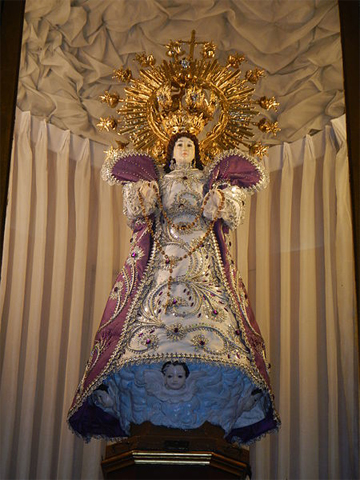
Nuestra Señorade los Remedios, Our Lady of Remedies
On the Feast of St Joseph the Worker, 1 May, Columban Fr Leo Distor was installed as Parish Priest of Our Lady of Remedies Parish, Malate, Manila, where the Columbans have worked since 1929 having taken the parish at the invitation of Irish-born Archbishop Michael O’Doherty of Manila at a time when the Philippines was desperately short of priests.
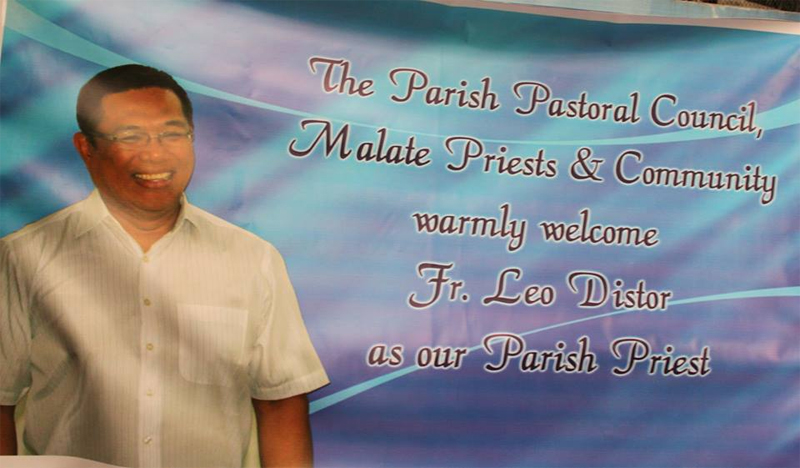
Fr Leo Distor
The parish of Malate, one of the oldest in the Philippines, was established in the sixteenth century by Augustinian friars. Fr Leo Distor, who has worked in the formation of Columban seminarians in Chicago and in Quezon City, is from Marbel, Mindanao, where he was ordained in 1996. He is the first Filipino parish priest of Nuestra Señora de los Remedios.
The Maynooth Mission to China was given the go-ahead by the bishops of Ireland on 10 October 1916. Two years later it became the Society of St Columban. The first group of priests went from Ireland to China in 1920. The two considered as co-founders were diocesan priests, Fr Edward Galvin, ordained in 1909, and Fr John Blowick, ordained in in 1913. Father Galvin had already spent some years in China with other Irish diocesan priests while Father Blowick was a professor of theology at St Patrick’s, Maynooth, the national seminary in Ireland.
The fact that the vast majority of those who joined the fledgling movement were either seminarians in Maynooth or had graduated from there was the reason for the name ‘Maynooth Mission to China’. For many years that, or ‘Maynooth Mission’ was the name by which the Columbans were best known in Ireland.
It took some persuasion on the part of Archbishop O’Doherty to get Columbans to come to the Philippines, as we had been founded to work in China. But God had other plans.
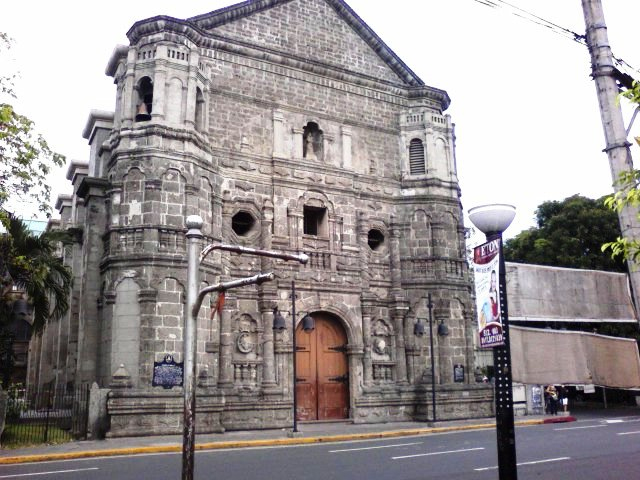
Malate Church
In Peace by Peace in this issue you can read an extract from the writings of a previous Columban Parish Priest of Malate, Fr John Henaghan from Ireland, killed by the Japanese during the Battle of Manila in February 1945.
Under the title ‘Our Lady of Remedies’ Mary is the patroness of childbirth. May she obtain abundant blessings for the new parish priest and the parishioners of Malate as a new reality is born among them.
Fr John Leydon blesses pets in Malate Church on the Feast of St Francis of Assisi
Resurrection after Yolanda
By Kurt Zion Pala
The author, a frequent contributor to Misyon, is a Columban seminarian continuing his studies in theology after two years on First Mission Assignment in Fiji. He is from Iligan City. Here he writes about a visit to areas ravaged by Super-typhoon Haiyan (Yolanda) on 8 November 2013.
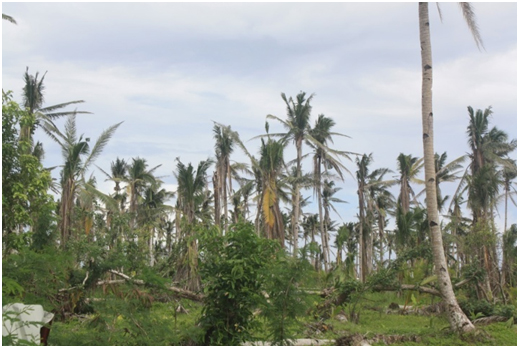 Before heading home for the school break, I decided to spend some time in Tacloban City, which was heavily damaged by typhoon Yolanda on 8 November. It took me almost 30 hours to get there by bus from Cubao, Quezon City, through the national highway and crossing the seas by ship from Matnog, Sorsogon, to Allen, Northern Samar, and eventually crossing the San Juanico Bridge into Tacloban City, Leyte on 24 March.
Before heading home for the school break, I decided to spend some time in Tacloban City, which was heavily damaged by typhoon Yolanda on 8 November. It took me almost 30 hours to get there by bus from Cubao, Quezon City, through the national highway and crossing the seas by ship from Matnog, Sorsogon, to Allen, Northern Samar, and eventually crossing the San Juanico Bridge into Tacloban City, Leyte on 24 March.
I could see the damage caused by Yolanda in the landscape – the hills and trees were bare. I was told that in the days after the typhoon there were only three colors, if you could call them such: black, grey and brown. There wasn’t much life left except for survivors. I was dumbstruck by the extent of the damage – large infrastructures like churches, mills, schools and buildings were all destroyed. Buttresses of mangled steel and mountains of scrap metal and roofs were everywhere.
I felt deeply sad when we passed by a churchyard at night – there were candles lit everywhere before crosses of different sizes. It turned out to be a mass grave for many who died in the typhoon. It had been more than a hundred days after the storm. I could see most of the city trying its best to recover and rebuild. People were back into the rhythm of their daily life. I saw their smiles and heard their laughter.
I participated in the General Mission conducted by the Redemptorists in Tacloban and nearby parishes in the Archdiocese of Palo, Leyte, one of a team composed of priests, seminarians and lay people for a week of activities. The theme of the mission was ‘Re-nurturing Faith, Re-kindling Hope and Re-building the People of God’. Much of the relief provided for the survivors had been more on the physical, social and psychological aspects, with little done to address their spiritual needs. The general mission hoped to fill this gap.
Our team covered two barangays of St Peter’s Parish, Tolosa, Leyte, San Roque and Opong. There were 830 household in San Roque and 513 in Opong. There were three reported deaths in Opong and none in San Roque. Most of the houses in both barangays were totally damaged. Structures such as schools, barangay and health centers were also badly damaged.
The schools had been reconstructed by the Korean Army. Most households were provided with temporary shelters like tents while they were rebuilding their homes. The chapel in Opong was also badly damaged with most of its roof ripped-off. That in San Roque was totally destroyed, only part of its facade remaining.
The group conducted activities which included a Lenten recollection, Mass, novena and Stations of the Cross, adult trauma release sessions, a children’s day and a youth night. There was plenty of sharing in groups and personal encounters. Most shared that they had lost everything but not their faith. It was God and their family that kept them alive at the height of and after the typhoon.
But one mother asked, ‘Why did God allow us to suffer because of the typhoon?’ Some felt guilty after Yolanda. I have also struggled with the same question after the death of a loved one. Does God will our suffering and pain? Of course not! God does not will that we suffer. God wills that we grow in love and faith, not in fear and pain. There are mysteries in life that we find difficult to understand – but in God’s time and grace they begin to unfold themselves to us. The Paschal Mystery – the story of the life, suffering, death and Resurrection of Christ - demonstrates the saving power and love of God through Christ. The people in Tolosa shared in that story of Christ.
During the Stations of the Cross around both barangays each station took on a more personal meaning for the people. Before we began we asked the people to identify their 14 crosses in relation to the cross of Christ and symbols to represent these: (1) hunger – empty plate; (2) destroyed houses - ; (3) lack of work or source of income – a rope; (4) lack of unity/ partisan politics – a broken chain: (5) health-related problems – an empty bottle of medicine; (6) education (lack of books and other school supplies) – a notebook and pen; (7) damaged barangay structures including the church/chapels –pieces of rubble; (8) temptations against faith– broken statues; (9) lack of help or no help from government agencies – coins; (10) problems with their families – a family picture; (11) climate change – a dried branch; (12) irresponsible governance specially at the barangay level – a clock; (13) their selves (selfishness, etc.) – a tattered shirt; (14) a symbol of hope – a green potted plant.
The General Mission emphasized two things needed for the communities to get back on their feet and get out of their situation: (1) Basic Ecclesial Community (BEC) Spirituality and (2) the Our Father as the prayer of the community. The only way out is for individuals to live their identity as baptized and as Christian communities guided by the BEC Spirituality is grounded in the definition of the Church as the People of God. The people must also live out the challenges that praying the ‘Our Father’ demands.
On the final night with the youth, I sat with seven young girls and boys. It was dark with only a candle in the middle of the group. I looked up and saw the stars. They were so bright in the dark. I seldom see such brightness, especially in the city. The stars reminded me that often we don’t see God’s presence and forget about him when everything around us is so distracting and fighting for our attention – false friendships, power and wealth. But in the dark, in our experience of suffering and pain – God becomes more present and real.
I would like to thank the Redemptorists for making me a part of their mission in Tacloban and the neighboring parishes. I came to see and my eyes were opened. They, the people taught me what faith in God means and what the deep joy of sharing is like. They are proofs of the Resurrection. Jesus Christ is alive in them! Jesus Christ is alive!
What’s Out There?
By Richelle H. Verdeprado
This article is based on an interview with Tom Schumann, a filmmaker from Germany.
It was an endeavor that started with the idea of making something for children. It was an idea that had been positively bothering the filmmaker, Tom Schumann, one and a half years ago. It was that same desire to turn the idea into a reality that brought him back to the Philippines, this time with his wife Annett and four-year-old daughter Somi to do a documentary on children speaking with their hands.
Tom's family enjoying a visit at the
Misyon office.
Tom’s first visit in the Philippines was in 1986, together with his father Uwe-Jens Schumann, his Mom and his brother. This visit was very significant for Tom because he first met a two-week-old girl who would later become his adopted sister. Due to the long adoption process it took six months and a number of trips to the Philippines before Tom’s parents could finally take her to Germany.
During those visits Tom witnessed his father’s involvement in Welcome Home in Bacolod City. Welcome Home started as a residence for out-of-town deaf students giving them access to education. Tom was able to meet the late Fr Joseph Coyle, a Columban priest who founded Welcome Home and who became involved with deaf people, celebrating Mass in Sign Language and initiating programs for them. He also met the late Mrs Salvacion ‘Salving’ Tinsay who became involved with the deaf too. Those visits affected Tom’s life immensely and even until now he can remember the joy that he felt when he first saw his sister and then meet the children of Welcome Home. In Tom’s words, ‘You don’t just forget them. You simply can’t'.
Tom is continually fascinated by the way people use their hands in speaking. His daughter was also fascinated and he thinks that if children from Berlin could see children from the Philippines ‘speaking with their hands’ they would also be fascinated. As a father, Tom realized that children have a common language and can understand things in the same, unique ways. ‘Kids love watching other kids’, Tom said. He also shared that when they were shooting the documentary, it was as if he was just having fun with the children. It became a lot easier than he thought it would be. ‘The actual shoot is not a challenge, but how to finish it is. Putting it together will make me sad because that means I’m already back home’, Tom added.
Souvenir photo with
our editor.
Tom
sharing his story with the author.<
According to Tom, another interesting feature of this video is that it portrays the children’s life as they are. Whatever happens is the story. In the nine days of shooting, most of the time was spent with the children. Tom and his family were learning Sign Language at the same time. His family is very supportive of him in this endeavor.
As a freelance film maker who has done commercial and fashion videos, Tom describes this project as being really different from what he has done before. There are no pressures in making it. It will be distributed for free and is a non-profit project. Tom is even happier because he could see that the children who were part of this documentary were enjoying themselves too. It’s a very honest story and the fact that it being told by children makes it more authentic.
Tom is envisioning filming at a school for the deaf and blind near Berlin as a second part of this documentary series for children. It is a dream that was stirred during his interaction with about 50 children from Welcome Home aged three to fifteen. These are a cross-section of children with amazing stories to tell, sharing the same classroom, speaking with their hands and communicating in the same language where understanding and love is at the core.
While doing this interview, I could feel Tom’s optimism and passion. He is fueled by that desire to let the children know what’s ‘out there’. But before the hands of these children will speak to the viewers, they have spoken to Tom first.Undoubtedly, the making of this video has spoken to him in a very special way. It has spoken to him in a way that crossed the bridge between German and Filipino, between adult and child, between deaf and hearing.
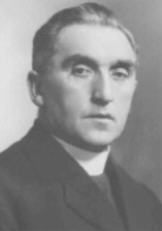

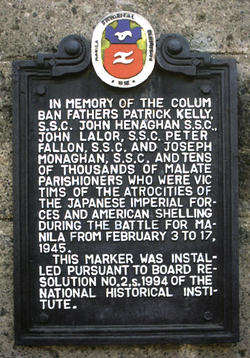 ‘Concerning the deaths of the five priests at Malate, less is known. They all died about February 9 of this year, just before General MacArthur entered Manila.
‘Concerning the deaths of the five priests at Malate, less is known. They all died about February 9 of this year, just before General MacArthur entered Manila.